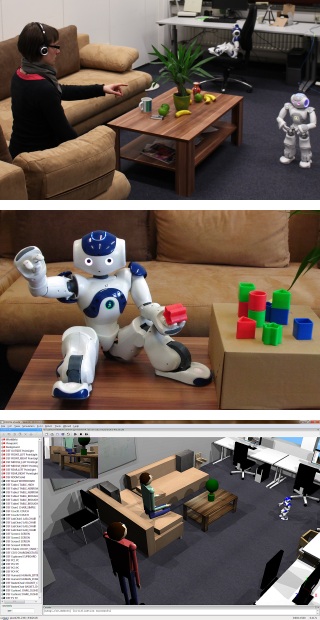Teaching
Project: Human-Robot Interaction/Mensch-Roboter Interaktion
Winter Semester 2011/2012 & Summer Semester 2012
News/Aktuelles
- The result of this project has been accepted for publication and was presented at the IEEE First International Conference on Cognitive Systems and Information Processing (CSIP 2012), Dec. 15-17, 2012, Beijing, China! Get the paper
- You can experience the result of this project at the Students EXPO 2012.
Project video demonstration
|
|
|
General Information/Allgemeine Informationen |
|
| LV-Number: | 64-466 + 64-467 |
| Lecturer : | Prof. Stefan Wermter, Dr. Cornelius Weber, Stefan Heinrich |
| Period: | Thu/Do 14-18 |
| Room: | F-235 |
| Credit Hours | 2 SWS Project + 2 SWS Seminar (Winter Semester) 4 SWS Project (Summer Semester) |
| Language: | English/Deutsch |
| Module: | MPM2 |
|
|
|
Contents/Inhalte
 |
|
|
What makes an humanoid robot human and social? And how can such a robot learn independently or by interaction with a person? This is the key topic in this project between interaction, cognition, learning and robotics.
Human-robot interaction is an interesting research area that allows to investigate how human capabilities to act intelligently can be implemented on humanoid robots. The topics in this project context are rich due to the wide range of the cognitive abilities like communication and problem solving allowing for dealing with complex tasks. To effectively evaluate sensor data or determine behavioural parameters, neural networks are of particular interest. Was macht einen humanoiden soziale Roboter aus und wie kann dieser selbstständig oder durch Interaktion mit dem Menschen lernen? Dies ist die zentrale Frage in diesem Projekt zwischen Interaktion, Kognition, Lernen und Robotik. Die Mensch-Roboter Interaktion ist deshalb so interessant, weil sie es uns ermöglicht zu untersuchen, wie die menschlichen Fähigkeiten zum intelligenten Handeln auf humanoide Roboter zu übertragen sind. Mit kognitiven Fähigkeiten, wie Kommunikation und Problemlösung, eine komplexe Aufgabe zu lösen, ist ein breites Forschungsfeld, aus dem sich viele ansprechende Themen ergeben. Um effektiv Sensordaten auszuwerten und Verhaltensparameter zu bestimmen, sind Neuronale Netze besonders interessant. |
|
|
|
Objective/Lernziel
The project Human-Robot Interaction offers the opportunity to learn the complexities of daily action and to gain first experiences in the area of humanoid robotics. Thereby essential concepts shall be developed and implemented in corresponding control algorithms for the robot. To deal with this complex task and to be able to develop an expandable software architecture, the problem will be segmented into several parts and solved in team work.Das Projekt Mensch-Roboter Interaktion bietet die Gelegenheit, die Komplexität einfacher täglicher Handlungen zu verstehen und auf dem Gebiet der humanoiden Robotik erste Erfahrungen zu sammeln. Dabei sollen die notwendigen Konzepte entwickelt und in entsprechende Steuerungsalgorithmen für den Roboter umgesetzt werden. Um die komplexe Aufgabe zu bewältigen und eine stetig erweiterbare Softwarearchitektur zu entwickeln, soll das Problem in Teile zerlegt und in Teamarbeit gelöst werden.
|
|
|
Procedure/Vorgehen
This course extends over two semesters. In WS10/11, the integrated seminar (2SWS) offers the opportunity for breaking into the topic and for choosing interesting topics that could be implemented. The practical project part (2 SWS) will provide the acquisition of the software, neuro-cognitive basics and the collective planning of the global architecture. The project will be continued with 4SWS in SS12. The programming of single skills of the robot will be carried out in teams of two students. At the end, it is desired to merge the implementations of all participants via a robot middleware. Finally, the results will be documented and presented.Die Veranstaltung erstreckt sich über zwei Semester. Im WS11/12 gibt es mit dem integrierten Seminar (2 SWS) Gelegenheit, sich in die Thematik einzuarbeiten und die interessanten Fähigkeiten, die dem Roboter verliehen werden können auszuwählen. Der Projektteil (2 SWS) dient zum Erlernen der Software, neurokognitiver Grundlagen und der gemeinsamen Planung der globalen Architektur. Das Projekt wird im SS12 mit 4 SWS fortgeführt. Eine Zusammenführung der Programme aller Teilnehmer durch eine Roboter Middleware ist angestrebt. Abschließend werden die Ergebnisse dokumentiert und präsentiert.
|
|
|
Literature/Literatur
- Robin R. Murphy. Introduction to AI Robotics. MIT Press, Cambridge, MA., 2000.
- Barbara Webb, Thomas R. Consi. Biorobotics - Methods and Applications. AAAI Press, Menlo Park, CA., 2001.
- Hideyuki Nakashima, Hamid Aghajan, Juan Carlos Augusto (Eds.). Handbook of ambient intelligence and smart environments. Springer, 2010.
- David Vernon, Claes Hofsten & Luciano Fadiga. A Roadmap for Cognitive Development in Humanoid Robots. Springer 2011. Online accessible
|
|
|
Material
In this project a humanoid interactive NAO robot as well as a simulation software will be used, which can be programmed without deep hardware or simulation knowledge. The NAO robot has 25 degrees of freedom, two cameras, four microphones and the abilities to walk autonomously, to talk and to detect optical landmarks. For an demanding interaction with a person, it can be extended by external sensors like a boundary microphone or an additional camera system.Im Projekt wird ein humanoider interaktiver NAO Roboter sowie eine Simulationssoftware eingesetzt, welche ohne tiefe Hardware- bzw. Hardwaresimulationskenntnisse programmiert werden können. Der NAO verfügt über 25 Freiheitsgrade, zwei Kameras, vier Mikrophone und ist bereits in der Lage selbstständig zu laufen, zu sprechen und optische Landmarken zu erkennen. Um auch anspruchsvoller mit Personen interagieren zu können, kann er mit weiteren externen Sensoren wie einem Raummikrofon oder einer zusätzlichen Kamera erweitert werden.
- Nao robot: http://www.aldebaran-robotics.com/en
- Webots simulation software: http://www.cyberbotics.com
Templates for seminar papers and presentations as well as further hints can be found on the web page: Hints for Seminars
Additional material for this course can be found within the MIN-CommSy portal:
Informatik-CommSy: WTM: Human-Robot Interaction 2011/12
|
|
|
This project is related to the topics of our European projects KSERA, RobotDoC and CINACS on interactive robots, which will allow participants to get in touch with the latest research in international project work.
Knowledge Technology international Projects: http://www.informatik.uni-hamburg.de/WTM/projects/